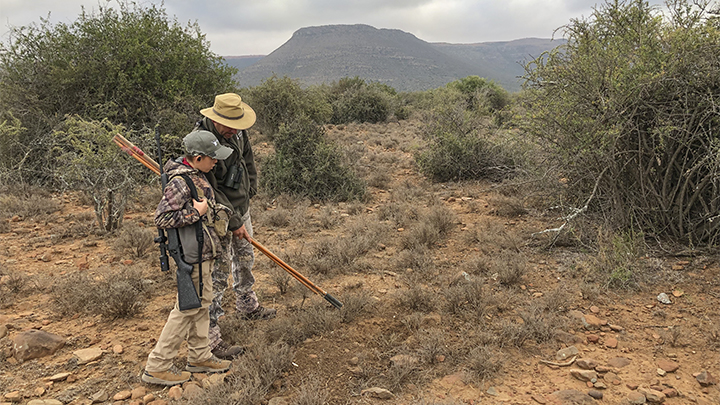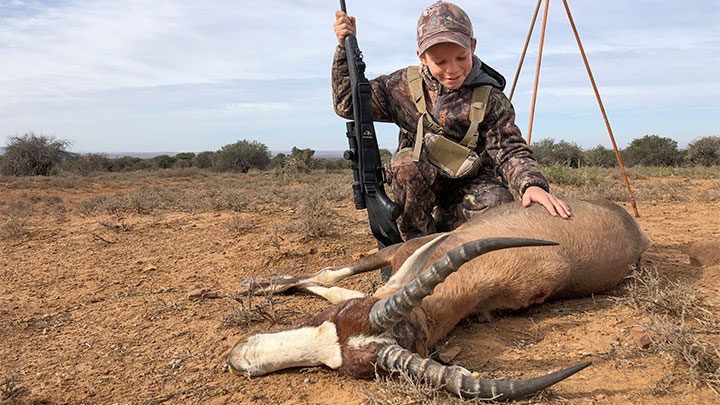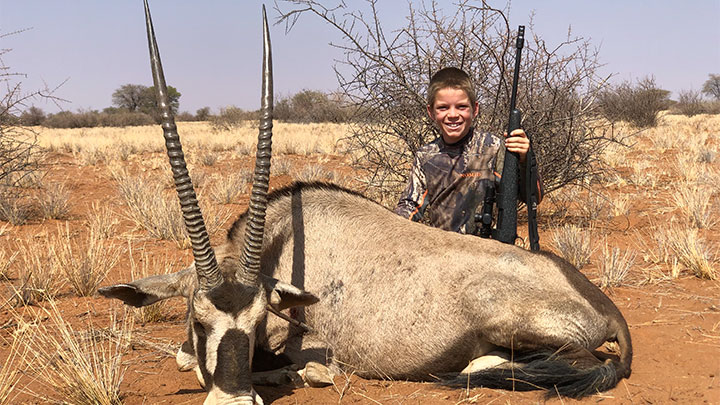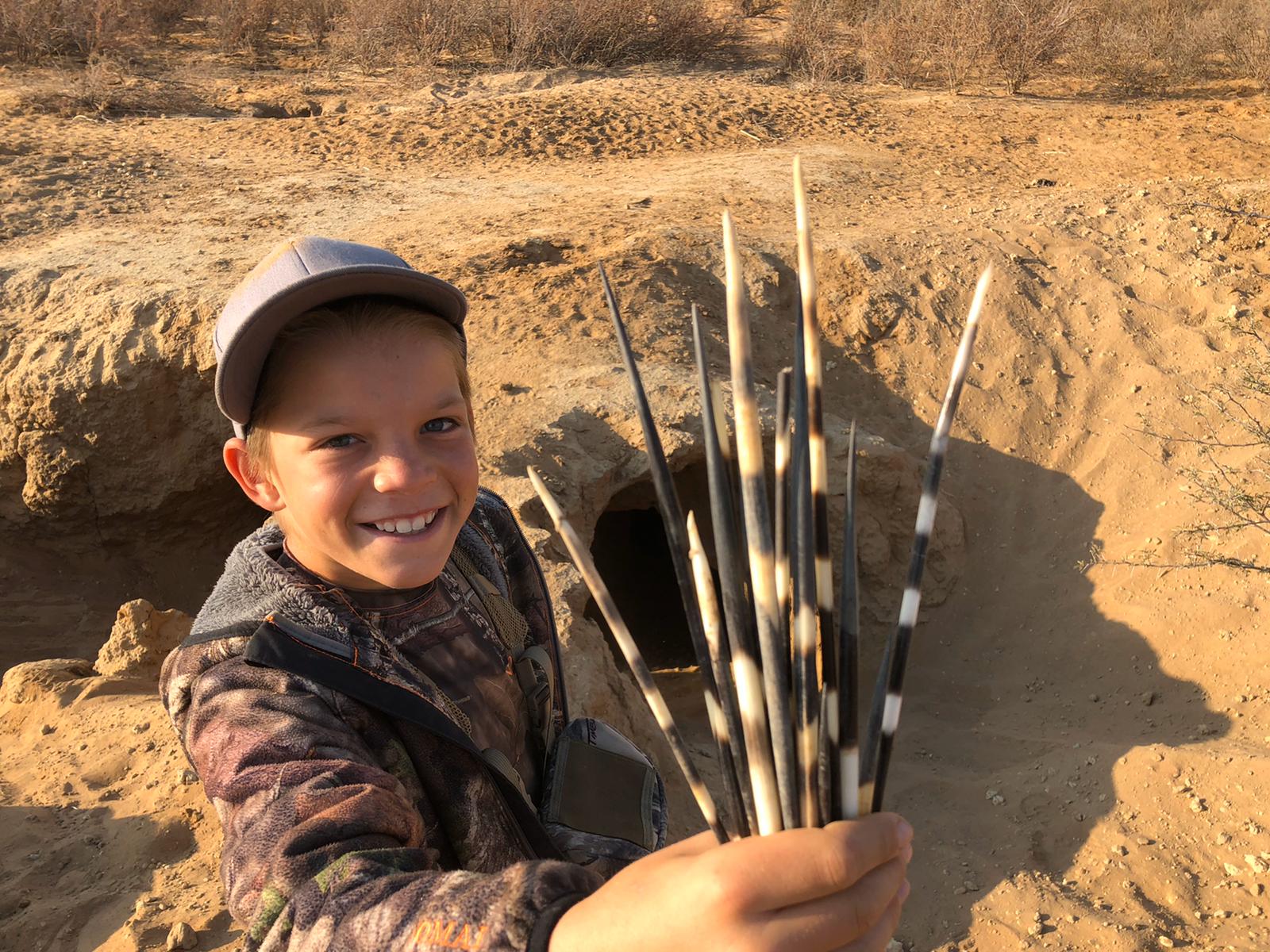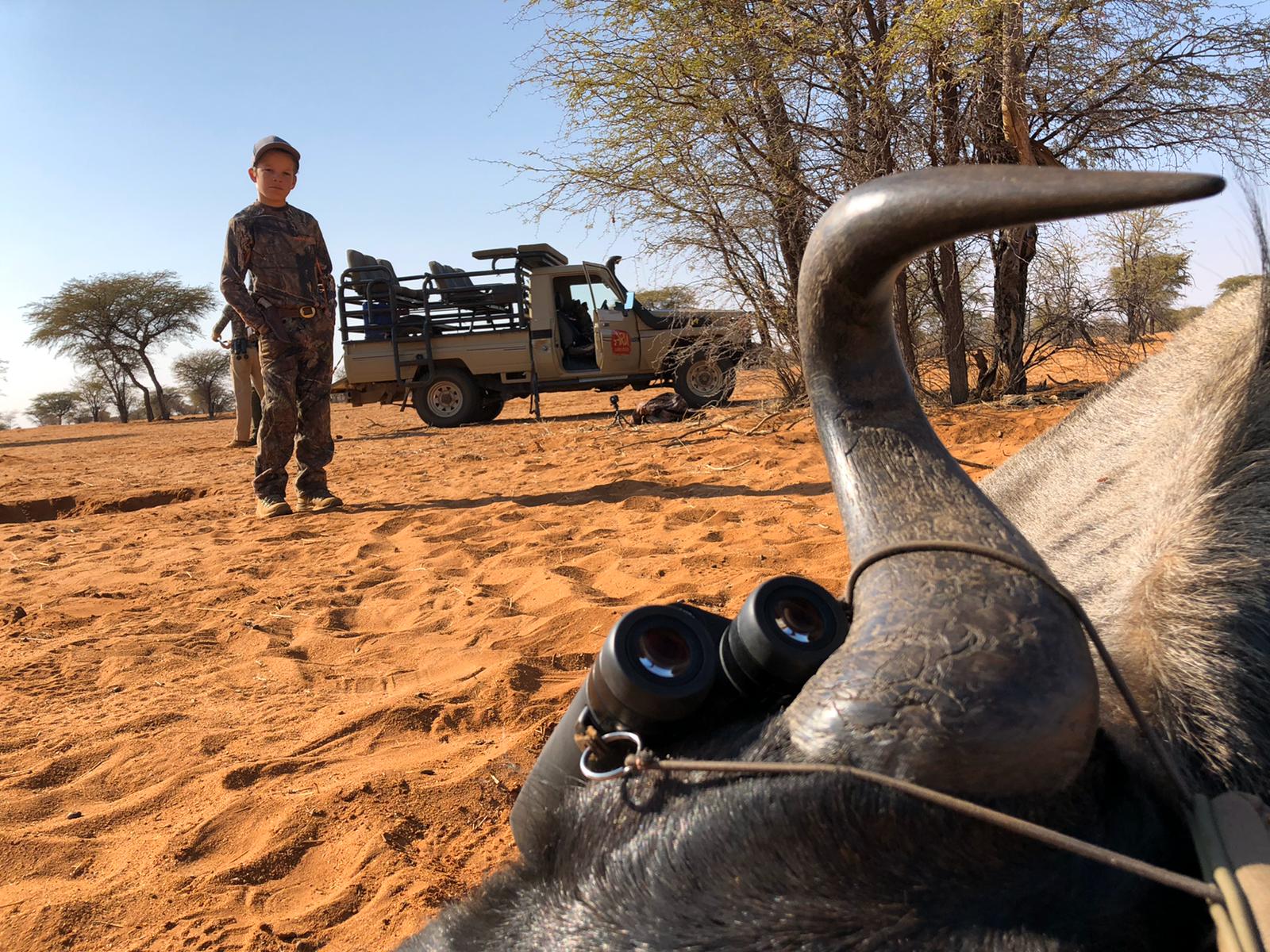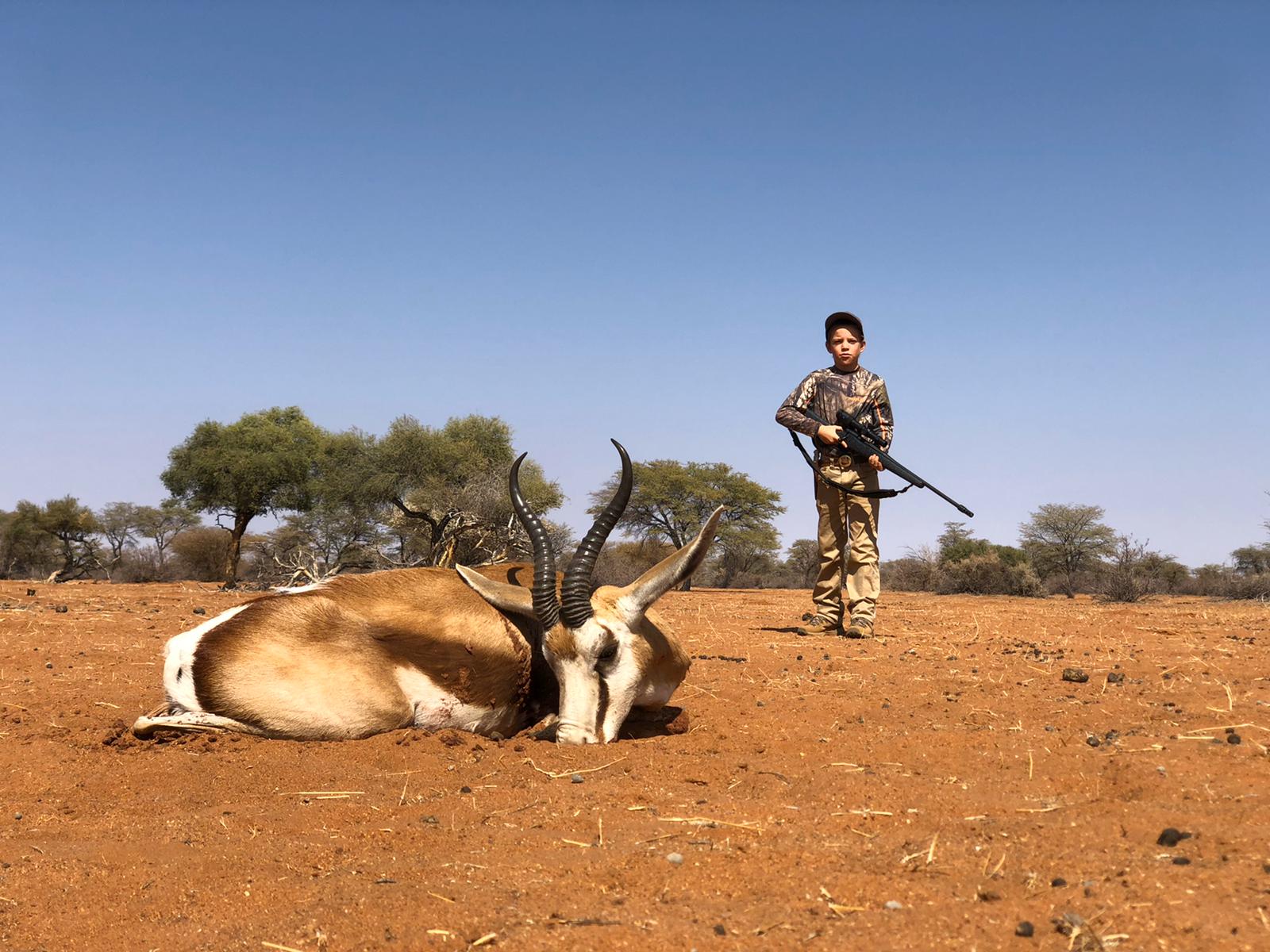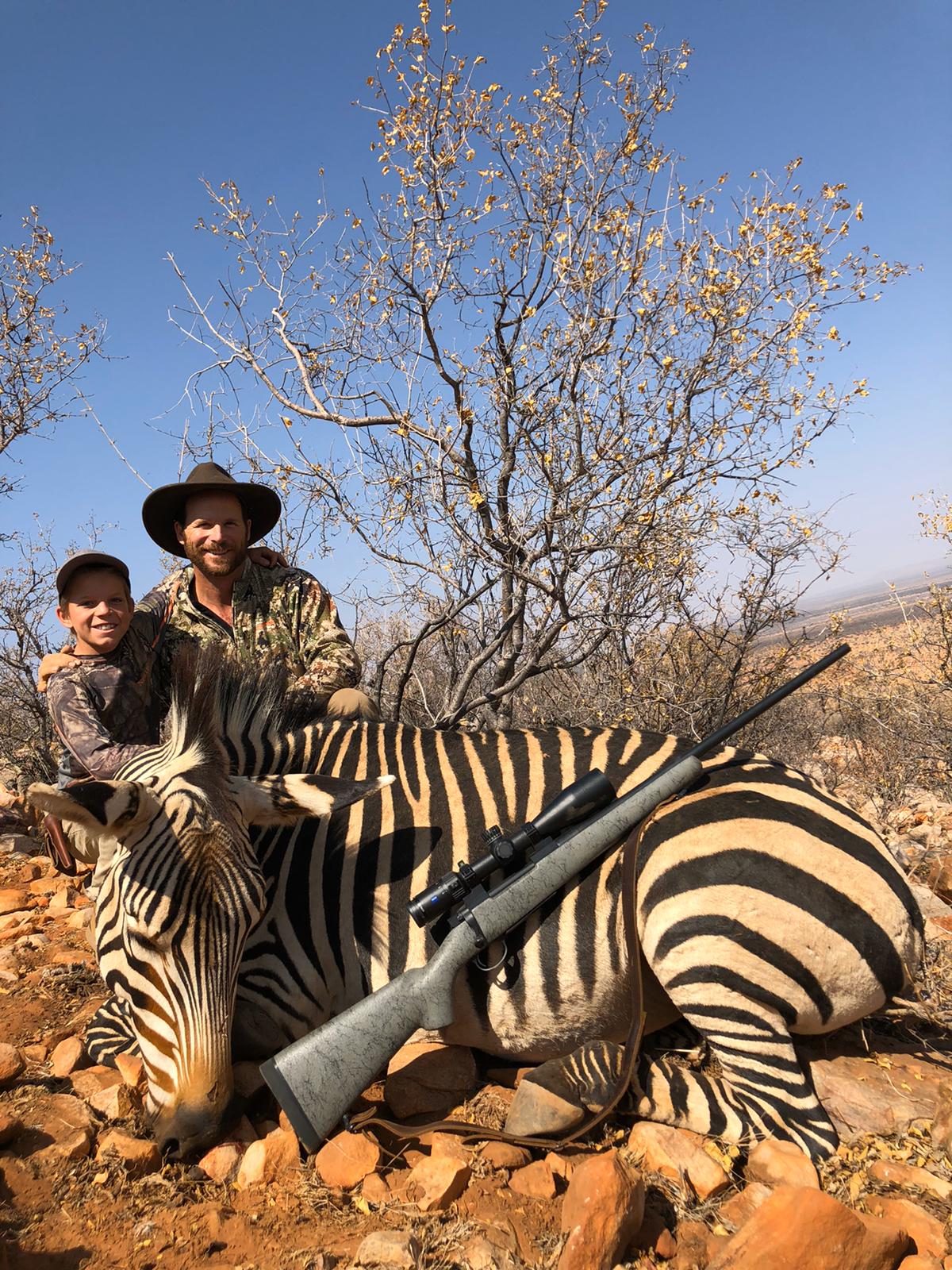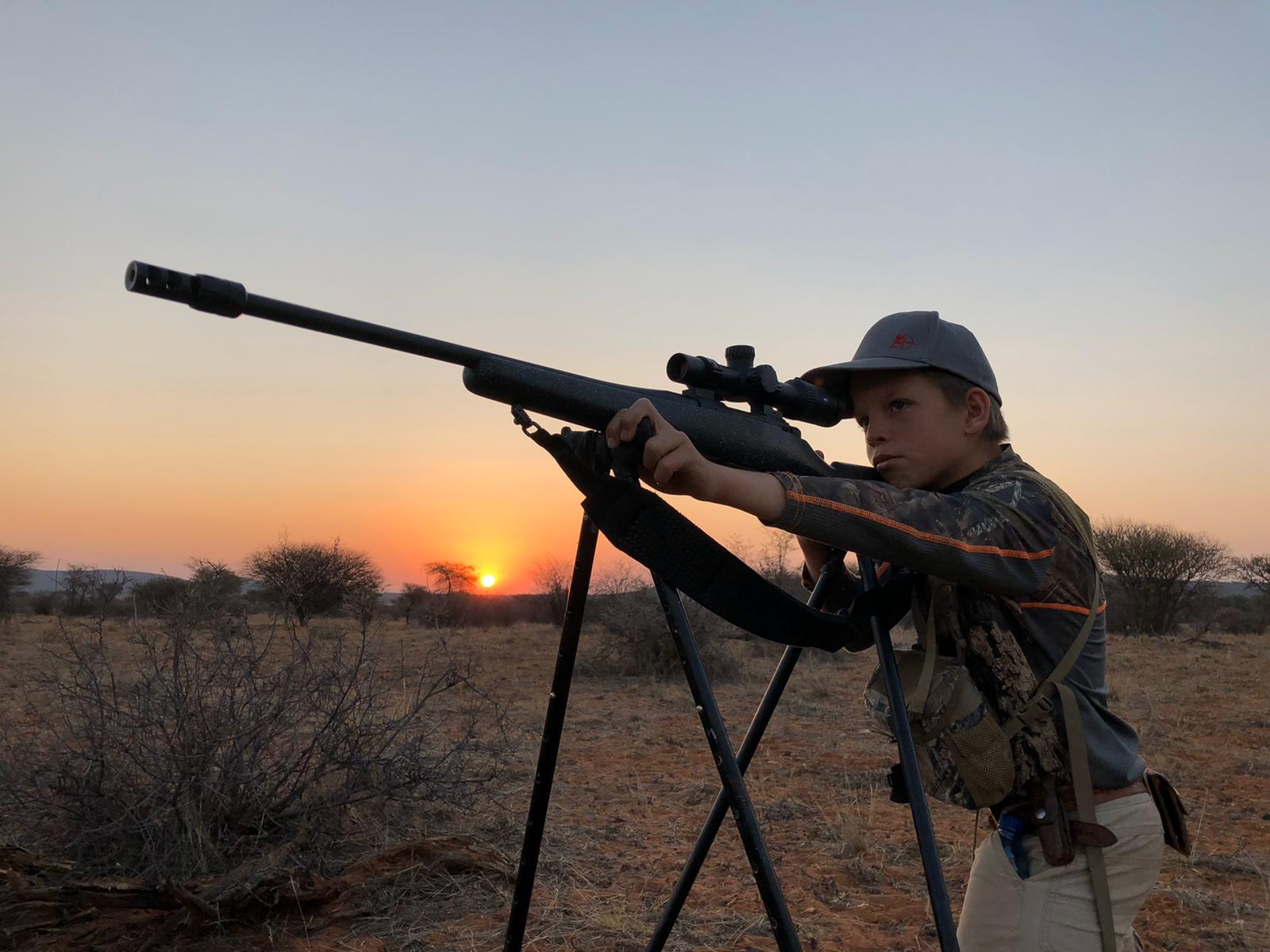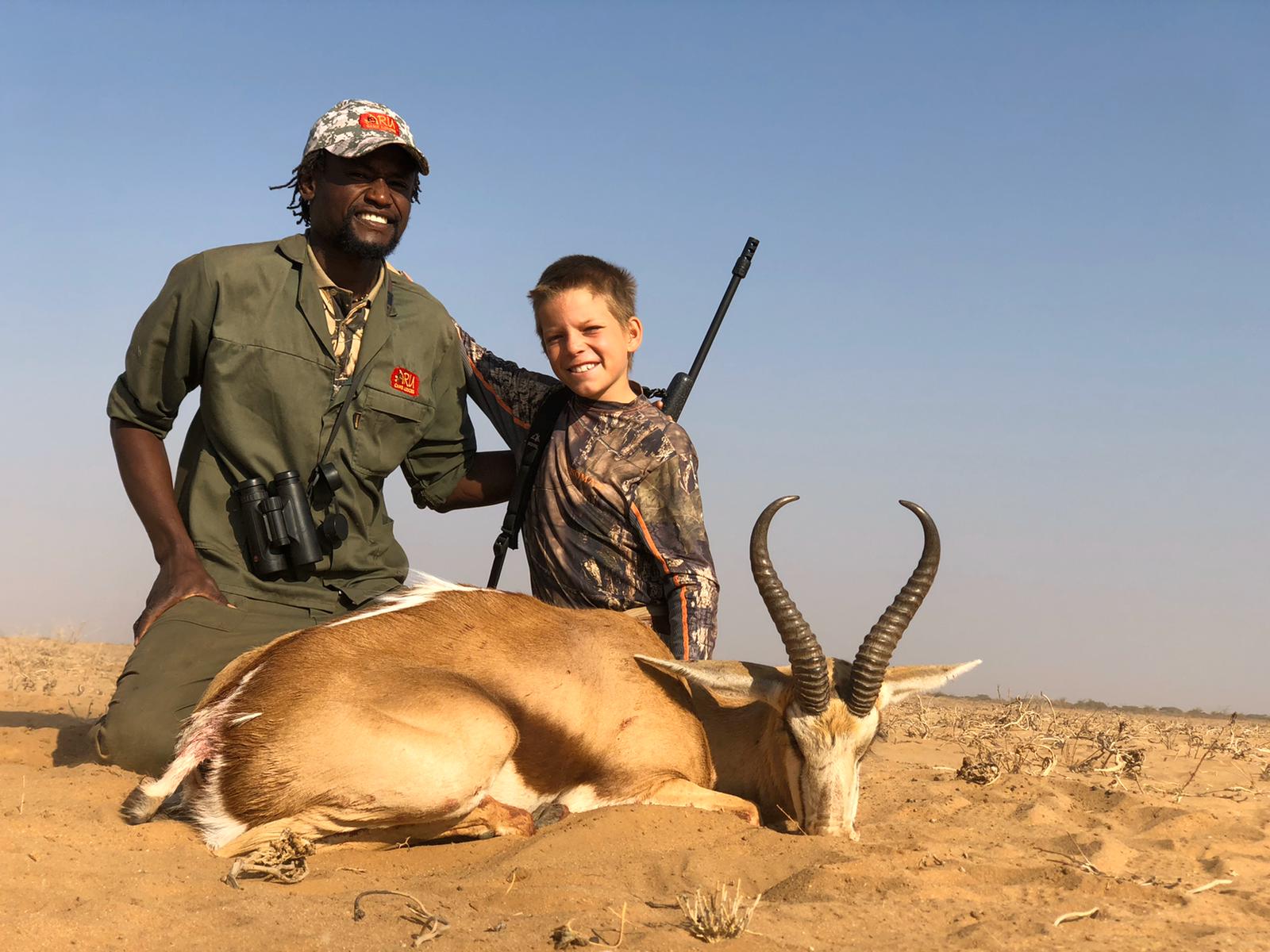Rites of Passage on the Sands of Africa
by Aram von Benedikt
My young son was the hunter, his small hands wrapped capably around the stock of my Nosler rifle, having left his own at the truck. Dust rose from underfoot, and the scent of the thornveld bit at our nostrils as we drifted along the spoor left by Africa’s largest plains game, hoping for just one good shot.
For almost two weeks we had walked the Dark Continent—hunting, learning, becoming acquainted with the ways of its wild ones. We spied porcupine dens, wondered at the way kudu bulls use their horns to break forage from the shepherds tree and listened to baboons shouting from the cliffs. Today was our last hunting day in Africa, and we shadowed a herd of some 40 eland. Drought was strong upon the land and we hoped to cull an old cow, easing pressure on the drought-stricken landscape by reducing competition for forage.
A First in South Africa
The third of three flights from Utah to Africa carried us to Port Elizabeth in South Africa’s Eastern Cape province, where we were met by Dave Davenport, owner of Leopard’s Valley Safaris. A wealth of local knowledge poured in a steady stream from the eighth-generation stockman as we climbed into his truck and drove several hours to his property, a breathtaking valley nestled against a huge horseshoe-shaped mountainside. In a country where high-fence hunting reigns king, Dave runs a low-fence operation that offers gritty, high-quality experiences to the adventure-minded hunter. We soaked up the sights of Africa, admired the abundant wildlife, and arrived at Leopard’s Valley exhausted but full of anticipation. A few quick shots through our rifles verified my Pelican Case had protected them from the baggage handlers’ abuse. Dusk fell as we dined on the best lamb I’ve ever eaten then collapsed into our beds.
The days at Leopard’s Valley rolled by like a blissful dream. Dave is a passionate naturalist and frequently paused the hunt to teach us about the wonders of wild Africa. He showed us miniscule ants that bite acacia thorns, injecting a substance that makes the thorns grow huge. Then the ants hollow out the thorns and live inside. Should an unsuspecting giraffe or other browser try to make a meal of the acacia the ants pour out of their nests to the attack, protecting the acacia and completing a symbiotic natural arrangement. He showed us trapdoor spider dens, territory-marking blesbok middens and the cement-like surface of termite mounds that protect the catacombs inside. And he showed us ancient lead bullets and cartridges he’d picked up, grim evidence of battles that had been fought across his land, reminders that the Dark Continent is ever a place of struggle and unrest.
On the third day we set up in a hollow surrounded by thornbush. A herd of blesbok trailed into the valley, inspired to movement by distant beaters. Several rams tangled themselves in the herd, always obscured by brush or other blesbok. This was Josiah’s first real opportunity to harvest a game animal, and I fervently hoped the hunting gods would bless him with good luck. The minutes grew long before finally a ram untangled from the mob and stood broadside, sunlit dust drifting slowly around him.
Rifle resting atop a short set of cross-sticks, Josiah fired, dropping the ram where he stood. We approached, and watched solemnly as the ram’s hair rippled and his body shivered one last time as life departed, leaving only meat and memories in its wake. Sadness mingled with gratitude in the age-old process of life-taking harvest as we celebrated Josiah’s clean kill. We knelt there in the African sand, and Josiah offered a prayer of thanksgiving and his apologies for taking life. Quiet pride filled my heart as I listened, my arm resting across his small strong shoulders.
On the third day, set up in a hollow surrounded by a thicket of thornbush, father and son watched a herd of blesbok meander into range… and Josiah’s first head of game fell shortly thereafter.
Several years earlier I had built a knife from an old rusty blade found while hunting the high alpine reaches of my favorite elk honey-hole. It was for Josiah, as a gift to celebrate his first harvest. I gave it to him now, happy to see the delight in his eyes as he tested the edge and buckled the sheath to his belt. Then Dave performed a ceremonial “blooding,” an old and honored rite signifying Josiah had now reached an age where he could provide and protect. Though I’d heard of the ceremony I’d never seen it, and found it fascinating and somehow moving. Josiah kept the blood on his cheeks until the next day, honoring the tradition.
The sun hung low over the horseshoe-shaped mountain on our last afternoon at Leopard’s Valley. We drank in the sights, smells and sounds of the Cape mountains, trying our best to record our memories in indelible mental ink. The next day, we bid farewell to our new friend and turned our faces toward the unknown.
On to Namibia
Freddie, a long-legged young man with a ready smile, led us in a long U-shaped stalk toward a herd of blue wildebeest. Several big bulls lurked within the herd, including one behemoth of a young bull—too young to shoot but plenty big enough to get this hunter’s heart pounding.
Guides from Aru Hunting Safaris had met us at a spectacular gate entrance along a dusty road deep in the heart of Namibia’s Dordabis region the afternoon before. Ceremoniously offering iced juice, champagne and a warm welcome, they then escorted us on a leisurely “game drive” to view abundant wildlife en route to the beautiful Veronica lodge, perched on a tree-covered dune above the floor of the Kalahari.
In Namibia, Josiah gazes at the work of a colony of sociable weaver birds. Resembling large hay bales, the nests are easy to spot hanging from trees.
Shots on game in Africa are typically made from a standing position with the aid of shooting sticks, and usually are kept around 150 yards or less. This is because tall grass usually prohibits taking a prone position, or even sitting. Now, however, there was no grass, and the red sand was warm against my chest as I crawled into position for a 270-yard shot at the wildebeest. It was a longer-than-usually-allowed shot, but my quiet assurance that I could kill the bull seemed to have convinced Eddie. I rested my rifle across my bino case, steadied the crosshairs against the sharply quartered-to bull Eddie pointed out and pressed the trigger. Dust erupted from the point of the bull’s shoulder, the herd disappeared in a cloud of more dust and the wildebeest lay still on the desert sand. We admired the hard bosses, the curving tips, and offered our respects to the old bull, wishing him well on his journey to the happy hunting grounds.
An oryx bull for Josiah was next on the menu, and we spent several days following Eddie through the Kalahari, tracking the bandit-faced, rapier-horned beasts. To visiting hunters, horn length is usually the deciding factor when determining a trophy of any species, but to an African PH, old age is the essence of a fantastic trophy. We spotted, pursued, and were evaded by several huge bulls, including one that would have gone 40 inches—the Holy Grail of gemsbok hunters.
The hunters spent several days tracking bandit-faced gemsbok in the Kalahari sand before Josiah took his first shot off sticks on a short-horned old bull.
We loaded a Land Cruiser full of packaged meat and clambered inside. Kalakwa, Aru’s mountain hunting area, was an hour’s drive away. En route we donated the load of meat to a rural boarding school. We could hear the voices of children singing from their classrooms as the principle shook our hands and thanked us for the meat. His gratitude was obvious and deep, and it became apparent to me that meat from local hunting operations was important to the well-being of the school. I watched the local children and thought of Josiah as Derek pointed the Land Cruiser toward Kalakwa. How would his life be different if he’d been born a kid in rural Africa? Doubtless it would be simpler, but also immeasurably harder. Josiah slept again as we drove toward Kalakwa, a spectacular lodge set in a valley surrounded by rugged Namibian mountains.
Our PH at Kalakwa was Benjamin, a keen-eyed hunter who seemed to know what the animals would do before they knew it themselves, and under his tutelage we hunted mountain zebra, ostrich and springbok, investigated huge African porcupine dens and looked at rhinoceros tracks in the sand. We stalked along a dry riverbed one evening, spotting warthog, steenbok, duiker and eland. An old stiletto-horned cow oryx appeared, and Josiah made another perfect shot with his 6.5 Creedmoor. The cow’s horns reached skyward as we took photographs in the dusk, later stretching a tape to 38 inches.
Two weeks seemed to pass in the blink of an eye, and our last day of hunting arrived. One goal remained: to test Federal’s new bullet on the biggest of African plains game, an eland. It was Josiah’s turn to hunt, so I handed him my rifle. Benjamin led us into a thicket of thornbush, and soon we crossed the tracks of a sizable herd of eland, moving into the wind. We followed, watching for dust and movement through the brush. Eventually we came upon the herd. We could hear sticks cracking as they fed, could hear their guttural vocalizations as they moved through the brush, only their legs visible some 35 yards distant. Benjamin was patient and we simply shadowed the herd, awaiting the right opportunity. Finally it came as an old cow trailed the herd across an open veldt, and the PH set the sticks for Josiah. I captured the 200-yard shot on film through my spotting scope, once again jubilant to see a perfect, center-shoulder hit. The old cow lurched some 10 yards and collapsed, rapidly succumbing to the well-placed bullet.
Home
The flight from Johannesburg, South Africa, to Atlanta, Ga., is one of the longest flights in the world at just shy of 17 hours in the air. That sounds like a long time, and it is, but as I sat almost-comfortably in my economy-class seat, listening to the sound of the jet turbines and reflecting on the previous two weeks, I knew that Josiah and I had left a piece of ourselves on the sands of Africa. We had learned and celebrated, mourned and bled, smiled and laughed. We had been mothered and taught, out there on the thornveld, by our guides and by Africa herself. I have no doubt that, given the opportunity, we will return to watch the sunset through the camelthorn and follow tracks across the Kalahari sand.


